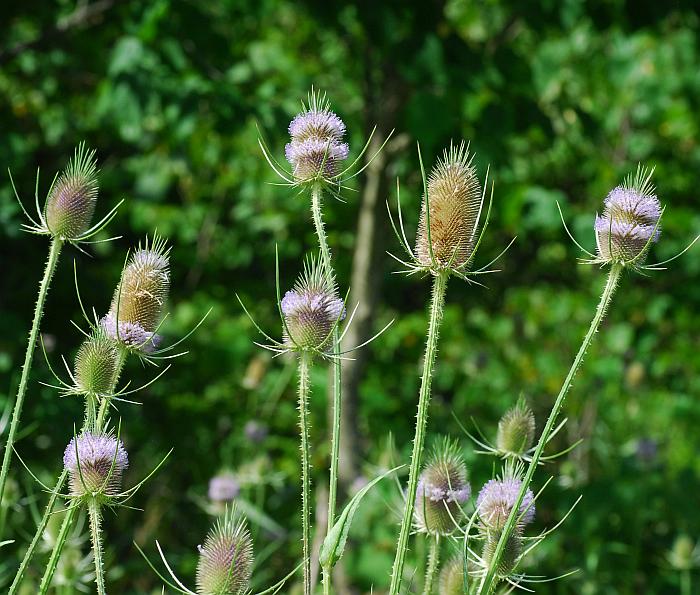Dipsacus fullonum L.
Common Teasel

Introduced
CC = *
CW = 3
MOC = 29
© SRTurner
Dipsacus fullonum L.Common Teasel | |
 |
Introduced CC = * CW = 3 MOC = 29 |
© SRTurner |
|
Family - Dipsacaceae Habit - Biennial forb. Stems - To +2m tall, from stout taproot, erect, herbaceous, carinate, with flattened straight prickles, branching above or simple.
Leaves - Opposite, linear-lanceolate, sessile, to +20cm long, +6cm broad, glabrous, with prickles on midrib (below) and on margins, acute. often basally connate. Basal leaves often drying by anthesis.
Inflorescence - Dense ovoid pedunculate cluster of many flowers terminating stem. Cluster subtended by ascending bracts to +/-10cm long. Bracts with straight prickles. Each flower subtended and cupped by an awn tipped chaff to +2cm long. Chaff pubescent, green to purple at apex.
Flowers - Corolla lavender at apex, whitish near base, to +1cm long, 4-lobed, dense pubescent on tube portion. Stamens 4, alternating with corolla lobes, adnate near apex of corolla tube, exserted. Filaments glabrous. Style well exserted, glabrous, white. Calyx tubular, 4-angled, 4-lobed, green. Achenes to +5mm long.
Flowering - June - October. Habitat - Fields, thickets, pastures, waste ground, open woods, roadsides, railroads. Origin - Native to Europe. Lookalikes - D. laciniatus. Other info. - This species is located in a number of Missouri counties, which are scattered with little defined geographical pattern. Both it and its sibling D. laciniatus are classified in Missouri as noxious weeds by a 2000 legislative act. The plants have infested roadsides in many areas of the state and threaten to invade natural areas. The plants are easily recognized on sight by their unique flower heads. D. fullonum differs from its lookalike D. laciniatus by usually having lavender rather than white flowers, and leaves which are less deeply lobed. In addition, the involucral bracts of D. fullonum arch upward, rather than spreading outward as in D. laciniatus. Photographs taken off Highway 77 near Partensburg, West Virginia, 7-20-02 (DETenaglia); also in Robertsville, Franklin County, MO, 7-19-2009 and 7-13-2017 (SRTurner). |